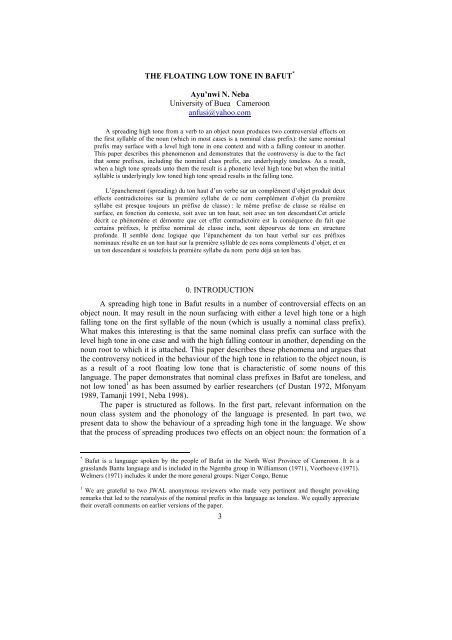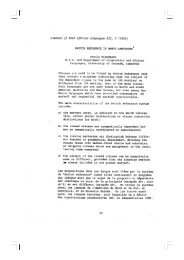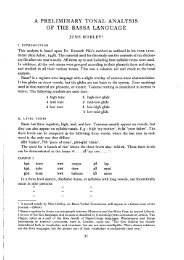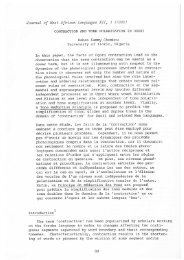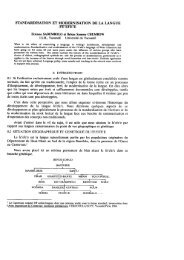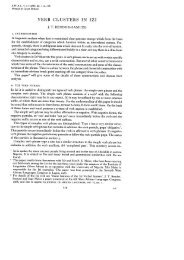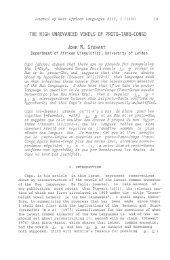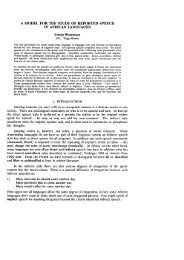The floating low tone in Bantu - Journal of West African Languages
The floating low tone in Bantu - Journal of West African Languages
The floating low tone in Bantu - Journal of West African Languages
Create successful ePaper yourself
Turn your PDF publications into a flip-book with our unique Google optimized e-Paper software.
THE FLOATING LOW TONE IN BAFUT *<br />
Ayu’nwi N. Neba<br />
University <strong>of</strong> Buea Cameroon<br />
anfusi@yahoo.com<br />
A spread<strong>in</strong>g high <strong>tone</strong> from a verb to an object noun produces two controversial effects on<br />
the first syllable <strong>of</strong> the noun (which <strong>in</strong> most cases is a nom<strong>in</strong>al class prefix): the same nom<strong>in</strong>al<br />
prefix may surface with a level high <strong>tone</strong> <strong>in</strong> one context and with a fall<strong>in</strong>g contour <strong>in</strong> another.<br />
This paper describes this phenomenon and demonstrates that the controversy is due to the fact<br />
that some prefixes, <strong>in</strong>clud<strong>in</strong>g the nom<strong>in</strong>al class prefix, are underly<strong>in</strong>gly <strong>tone</strong>less. As a result,<br />
when a high <strong>tone</strong> spreads unto them the result is a phonetic level high <strong>tone</strong> but when the <strong>in</strong>itial<br />
syllable is underly<strong>in</strong>gly <strong>low</strong> <strong>tone</strong>d high <strong>tone</strong> spread results <strong>in</strong> the fall<strong>in</strong>g <strong>tone</strong>.<br />
L’épanchement (spread<strong>in</strong>g) du ton haut d’un verbe sur un complément d’objet produit deux<br />
effects contradictoires sur la première syllabe de ce nom complément d’objet (la première<br />
syllabe est presque toujours un préfixe de classe) : le même prefixe de classe se réalise en<br />
surface, en fonction du contexte, soit avec un ton haut, soit avec un ton descendant.Cet article<br />
décrit ce phénomène et démontre que cet effet contradictoire est la conséquence du fait que<br />
certa<strong>in</strong>s préfixes, le préfixe nom<strong>in</strong>al de classe <strong>in</strong>clu, sont dépourvus de tons en structure<br />
pr<strong>of</strong>onde. Il semble donc logique que l’épanchement du ton haut verbal sur ces préfixes<br />
nom<strong>in</strong>aux résulte en un ton haut sur la première syllable de ces noms compléments d’objet, et en<br />
un ton descendant si toutefois la première syllabe du nom porte déjà un ton bas.<br />
0. INTRODUCTION<br />
A spread<strong>in</strong>g high <strong>tone</strong> <strong>in</strong> Bafut results <strong>in</strong> a number <strong>of</strong> controversial effects on an<br />
object noun. It may result <strong>in</strong> the noun surfac<strong>in</strong>g with either a level high <strong>tone</strong> or a high<br />
fall<strong>in</strong>g <strong>tone</strong> on the first syllable <strong>of</strong> the noun (which is usually a nom<strong>in</strong>al class prefix).<br />
What makes this <strong>in</strong>terest<strong>in</strong>g is that the same nom<strong>in</strong>al class prefix can surface with the<br />
level high <strong>tone</strong> <strong>in</strong> one case and with the high fall<strong>in</strong>g contour <strong>in</strong> another, depend<strong>in</strong>g on the<br />
noun root to which it is attached. This paper describes these phenomena and argues that<br />
the controversy noticed <strong>in</strong> the behaviour <strong>of</strong> the high <strong>tone</strong> <strong>in</strong> relation to the object noun, is<br />
as a result <strong>of</strong> a root <strong>float<strong>in</strong>g</strong> <strong>low</strong> <strong>tone</strong> that is characteristic <strong>of</strong> some nouns <strong>of</strong> this<br />
language. <strong>The</strong> paper demonstrates that nom<strong>in</strong>al class prefixes <strong>in</strong> Bafut are <strong>tone</strong>less, and<br />
not <strong>low</strong> <strong>tone</strong>d 1 as has been assumed by earlier researchers (cf Dustan 1972, Mfonyam<br />
1989, Tamanji 1991, Neba 1998).<br />
<strong>The</strong> paper is structured as fol<strong>low</strong>s. In the first part, relevant <strong>in</strong>formation on the<br />
noun class system and the phonology <strong>of</strong> the language is presented. In part two, we<br />
present data to show the behaviour <strong>of</strong> a spread<strong>in</strong>g high <strong>tone</strong> <strong>in</strong> the language. We show<br />
that the process <strong>of</strong> spread<strong>in</strong>g produces two effects on an object noun: the formation <strong>of</strong> a<br />
* Bafut is a language spoken by the people <strong>of</strong> Bafut <strong>in</strong> the North <strong>West</strong> Prov<strong>in</strong>ce <strong>of</strong> Cameroon. It is a<br />
grasslands <strong>Bantu</strong> language and is <strong>in</strong>cluded <strong>in</strong> the Ngemba group <strong>in</strong> Williamson (1971), Voorhoeve (1971).<br />
Welmers (1971) <strong>in</strong>cludes it under the more general groups: Niger Congo, Benue<br />
1 We are grateful to two JWAL anonymous reviewers who made very pert<strong>in</strong>ent and thought provok<strong>in</strong>g<br />
remarks that led to the reanalysis <strong>of</strong> the nom<strong>in</strong>al prefix <strong>in</strong> this language as <strong>tone</strong>less. We equally appreciate<br />
their overall comments on earlier versions <strong>of</strong> the paper.<br />
3
››<br />
››<br />
››<br />
››<br />
4 <strong>Journal</strong> <strong>of</strong> <strong>West</strong> <strong>African</strong> <strong>Languages</strong> XXXI.1 (2004)<br />
high fall<strong>in</strong>g (^) <strong>tone</strong> <strong>in</strong> some situations and a level high ( )<strong>in</strong> others. In the third part we<br />
attempt an analysis <strong>of</strong> the data presented, show<strong>in</strong>g with adequate illustration that the<br />
contour formation is due to a <strong>float<strong>in</strong>g</strong> <strong>low</strong> <strong>tone</strong> <strong>in</strong> the root. In the fourth part we provide<br />
evidence for the postulation <strong>of</strong> a <strong>float<strong>in</strong>g</strong> <strong>low</strong> <strong>tone</strong> <strong>in</strong> the analysis by exam<strong>in</strong><strong>in</strong>g negative<br />
noun derivations <strong>in</strong> Bafut. <strong>The</strong> paper ends with a summary conclusion.<br />
1. PRELIMINARIES<br />
1.1 A REVIEW OF BAFUT NOUN CLASSES 2<br />
<strong>The</strong> fol<strong>low</strong><strong>in</strong>g 10 noun classes have been identified for Bafut by earlier<br />
researchers (see Eastlack (1968), Dunstan (1971), Leroy (1977) Mfonyam (1989)<br />
Tamanji (1991) Neba (1998)).<br />
› (1) Cl 1a O - Cl 2 bˆ› -<br />
s bird bs birds<br />
l horse b horses<br />
kar r<strong>in</strong>g bkar r<strong>in</strong>gs<br />
kasar cassava bkasar cassavas<br />
› Cl 1b N›<br />
-<br />
ndoo husband bloo husbands 4<br />
nl greedy person bl greedy people<br />
nln old person bln old people<br />
mf chief bf chiefs<br />
› › Cl 3a ˆ› - Cl 6 m ˆ› -<br />
l palm w<strong>in</strong>e source ml palm w<strong>in</strong>e sources<br />
b s<strong>in</strong> mb s<strong>in</strong>s<br />
saa case msaa cases<br />
l ant ml ants<br />
b mushroom mb mushrooms<br />
3 This is a syllabic nasal that agrees <strong>in</strong> place <strong>of</strong> articulation with the fol<strong>low</strong><strong>in</strong>g consonant. This nasal is also<br />
attested <strong>in</strong> classes 3, 9, and 10. While it is replaced <strong>in</strong> the plural <strong>in</strong> class 1a, it is not <strong>in</strong> the other classes.<br />
4 <strong>The</strong>re are some situations <strong>in</strong> this language where [d] is realized as [l] <strong>in</strong> <strong>in</strong>tervocalic position. This<br />
change is not consistent as there are situations where [d] occurs <strong>in</strong> <strong>in</strong>tervocalic position, for example,<br />
[ad] ‘place’. This issue is out <strong>of</strong> the scope <strong>of</strong> this paper and we therefore not discuss it <strong>in</strong> any<br />
detail.
››<br />
››<br />
NEBA: <strong>The</strong> <strong>float<strong>in</strong>g</strong> <strong>tone</strong> <strong>in</strong> Bafut<br />
5<br />
› Cl 3b N› -<br />
a root ma roots<br />
ar gun mar guns<br />
nsoo farm mnsoo farms<br />
m gun mm guns<br />
Cl 5 n -<br />
nkuu bean mkuu beans<br />
nba w<strong>in</strong>g mba w<strong>in</strong>gs<br />
nb cola nut mb cola nuts<br />
Cl 7 a – Cl 8 -<br />
ats cloth ts clothes<br />
abaa door baa doors<br />
aka pan ka pans<br />
al curse l curses<br />
Cl 9 N -<br />
Cl 10 Nmb<br />
goat mb goats<br />
u fowl u fowls<br />
nda house nda houses<br />
mbu dog mbu dogs<br />
Cl 19 ffndz<br />
fa<br />
fnsa<br />
fk<br />
star<br />
salt<br />
broom<br />
wood<br />
Nouns <strong>in</strong> class 19 take their plurals <strong>in</strong> class 6 whose prefix is mˆ› ›-. Classes 9 and<br />
10 are <strong>in</strong>terest<strong>in</strong>g <strong>in</strong> the sense that the plural marker for this class is identical with the<br />
s<strong>in</strong>gular prefix. <strong>The</strong> difference between the two classes is noticed <strong>in</strong> their concord<br />
system. For example, the determ<strong>in</strong>er “the” is different for the two classes as shown<br />
be<strong>low</strong>.<br />
nda ja the house nda da the houses<br />
Notice also that all the nom<strong>in</strong>al prefixes carry a <strong>low</strong> <strong>tone</strong>.
6 <strong>Journal</strong> <strong>of</strong> <strong>West</strong> <strong>African</strong> <strong>Languages</strong> XXXI.1 (2004)<br />
1.2 RELEVANT PHONOLOGICAL RULES<br />
Two contiguous syllabic peaks across morpheme boundaries are not permitted <strong>in</strong><br />
this language. As a result, when two vowels are juxtaposed one <strong>of</strong> them (the second)<br />
deletes. <strong>The</strong> rule <strong>in</strong> 2a will capture this.<br />
(2) a. V Ø/ V+<br />
If one <strong>of</strong> the two syllabic peaks is a syllabic nasal, the nasal desyllabifies as stipulated<br />
by rule 2b.<br />
(2) b. N N / V<br />
[+syll] [-syll]<br />
<strong>The</strong>se two rules are very crucial for the discussions <strong>in</strong> this paper<br />
3. HIGH TONE SPREAD<br />
In Bafut, a high <strong>tone</strong> always spreads onto an object noun, which carries a <strong>low</strong><br />
<strong>tone</strong> <strong>in</strong> isolation. Normally, this results <strong>in</strong> the fol<strong>low</strong><strong>in</strong>g TBU be<strong>in</strong>g high <strong>tone</strong>d, with<br />
no evidence <strong>of</strong> there hav<strong>in</strong>g ever been a <strong>low</strong> <strong>tone</strong> present. <strong>The</strong> data <strong>in</strong> 3a illustrate this.<br />
(<strong>The</strong> constructions here are <strong>in</strong> the imperative).<br />
(3) a. (i) /fa + bloo/ [fabloo] give husbands<br />
(ii) /fa + nb/ [fanb] give a pumpk<strong>in</strong><br />
(iii) / fa + mluu/ [famluu] give some w<strong>in</strong>e<br />
(iv) / fa + ft/ [faft] give a calabash<br />
<strong>The</strong> nouns that have been collocated with the verb [fa] “give” have been<br />
selected from different classes 5 . 3a (i) is from class 2, 3a(ii) from class 5, 3a(iii) from<br />
class 6 and 3a (iv) from class 19. One th<strong>in</strong>g is clear <strong>in</strong> the data <strong>in</strong> 3a – that a spread<strong>in</strong>g<br />
high <strong>tone</strong> can lead to a level high <strong>tone</strong> on the <strong>in</strong>itial syllable <strong>of</strong> the object noun. This<br />
HTS rule can be formulated as shown <strong>in</strong> 3b 6 be<strong>low</strong>.<br />
5 We have paid attention here only to the noun classes with a CV- nom<strong>in</strong>al prefix because they show high<br />
<strong>tone</strong> spread dist<strong>in</strong>ctively. If we were to take class 3 or 7 nouns, the <strong>in</strong>itial Vowel or syllabic nasal will have<br />
to be deleted or desyllabified respectively (Rule 2) and one will not be able to notice the HTS.<br />
6 <strong>The</strong> f<strong>in</strong>al fall<strong>in</strong>g <strong>tone</strong> <strong>in</strong> the surface representation (SR) is a result <strong>of</strong> an <strong>in</strong>tonational <strong>low</strong> <strong>tone</strong> that surfaces<br />
at the end <strong>of</strong> any phrase. Consider the fol<strong>low</strong><strong>in</strong>g as example:<br />
fa ‘ive’ famu ‘ive a child’ famuwa ‘ive the child’<br />
<strong>The</strong> phrasal <strong>tone</strong> is always realized on the last syllable <strong>of</strong> the phrase <strong>in</strong> this language. This is why most<br />
utterances <strong>in</strong> this language either end <strong>in</strong> a fall<strong>in</strong>g <strong>tone</strong> or a <strong>low</strong> <strong>tone</strong>.
NEBA: <strong>The</strong> <strong>float<strong>in</strong>g</strong> <strong>tone</strong> <strong>in</strong> Bafut<br />
7<br />
(3) b. V V HTS rule<br />
H<br />
Interest<strong>in</strong>gly, however, is the fact that <strong>in</strong> some cases, when the high <strong>tone</strong> spreads<br />
onto the fol<strong>low</strong><strong>in</strong>g <strong>low</strong> <strong>tone</strong>d TBU, the result is a high fall<strong>in</strong>g <strong>tone</strong> with downstep<br />
occurr<strong>in</strong>g on any high <strong>tone</strong> that fol<strong>low</strong>s that fall<strong>in</strong>g <strong>tone</strong>. <strong>The</strong> data <strong>in</strong> 4 illustrate this.<br />
(4) a. (i) / fa + b s/ [fabs] give birds<br />
(ii) / fa + b lm / [fablm] give Lums 7<br />
b. (i) / fa + n mf/ [fanmf] give some fat<br />
(ii) / fa + n / [fan] give some planta<strong>in</strong><br />
c. (i) /fa + m mf/ [fammf] give some fats<br />
(ii) / fa + m / [fam] give some planta<strong>in</strong>s<br />
d. (i) /fa + ndz/ [fafndz] give a star<br />
(ii) / fa + f a/ [fafa] give some salt<br />
Notice that <strong>in</strong> these data we have the same nom<strong>in</strong>al class prefixes as <strong>in</strong> 3a above.<br />
<strong>The</strong>se prefixes that surface with a level high <strong>tone</strong> after HTS <strong>in</strong> 3a now bear a fall<strong>in</strong>g<br />
<strong>tone</strong> <strong>in</strong> 4.<br />
<strong>The</strong> question to be answered here is: why does high <strong>tone</strong> spread result <strong>in</strong> a high<br />
<strong>tone</strong> <strong>in</strong> one case and <strong>in</strong> a high fall<strong>in</strong>g <strong>in</strong> another on the same morpheme? In the<br />
fol<strong>low</strong><strong>in</strong>g section, we attempt provid<strong>in</strong>g an answer to this question by argu<strong>in</strong>g that<br />
fall<strong>in</strong>g high <strong>tone</strong> <strong>in</strong> 4 above is as a result <strong>of</strong> a lexical <strong>float<strong>in</strong>g</strong> <strong>tone</strong> that characterises the<br />
root nouns to which the prefixes are attached.<br />
3. DATA ANALYSIS<br />
An observation <strong>of</strong> the data <strong>in</strong> 4 reveals that apart from 4a, all the others (from b –<br />
d) have <strong>in</strong>itial root nasals. This is true for all the nouns <strong>of</strong> classes 5, 6, and 19. That is,<br />
as far as these three classes are concerned only the nouns with <strong>in</strong>itial root nasals<br />
surface with a fall<strong>in</strong>g <strong>tone</strong> after the application <strong>of</strong> HTS.<br />
In the data <strong>in</strong> 3a, one can notice that all the nouns are class 1a nouns (see section<br />
2.1). Class 1b nouns where the class prefix is overtly a nasal (which is replaced <strong>in</strong> the<br />
plural form) behave differently. To understand this, see the data <strong>in</strong> 5 be<strong>low</strong>.<br />
(5) a. Noun (sg) Plural Give + Noun(pl) Gloss<br />
s bs [fabs] birds<br />
kar bkar [fabkar] r<strong>in</strong>g<br />
7 ‘Lum’ is a female name.
››<br />
››<br />
8 <strong>Journal</strong> <strong>of</strong> <strong>West</strong> <strong>African</strong> <strong>Languages</strong> XXXI.1 (2004)<br />
››<br />
b. mf bf [fabf] chiefs<br />
nln bˆ› ›lwI› ›n [fabln] old person<br />
As shown <strong>in</strong> these data, class 1b nouns (5b) have a nasal as a nom<strong>in</strong>al prefix,<br />
which is replaced by the class 2 nom<strong>in</strong>al, prefix bˆ› ›-, when they form the plural. When<br />
those plurals are collocated with a verb, the result is the level high <strong>tone</strong> on the prefix.<br />
Class 1a nouns on their part do not have an overt nom<strong>in</strong>al prefix. When they take the<br />
class 2 nom<strong>in</strong>al prefix to form the plural, we notice a fall<strong>in</strong>g <strong>tone</strong> on the prefix (5a).<br />
<strong>The</strong> po<strong>in</strong>t that we are mak<strong>in</strong>g here is that it is easy to predict which nouns will surface<br />
with a level high <strong>tone</strong> and which will surface with a fall<strong>in</strong>g <strong>tone</strong> after HTS applies.<br />
<strong>The</strong> fact that these two groups <strong>of</strong> nouns (all nouns with root <strong>in</strong>itial nasals and<br />
class 1a nouns) behave the same suggests that there must be common features that<br />
these nouns have that the others do not.<br />
<strong>The</strong> solution that we propose to this problem is that, where the application <strong>of</strong><br />
HTS results <strong>in</strong> a fall<strong>in</strong>g contour <strong>tone</strong> formation, there is always a <strong>float<strong>in</strong>g</strong> lexical <strong>low</strong><br />
<strong>tone</strong>. <strong>The</strong> formation <strong>of</strong> a level high <strong>tone</strong> on the nom<strong>in</strong>al prefix is normal because it<br />
<strong>in</strong>volves the spread<strong>in</strong>g <strong>of</strong> a high <strong>tone</strong> onto a <strong>tone</strong>less TBU (Tone Bear<strong>in</strong>g Unit). <strong>The</strong><br />
implication <strong>of</strong> this assumption is that the nom<strong>in</strong>al class prefixes <strong>in</strong> this language are<br />
<strong>tone</strong>less. <strong>The</strong> derivations be<strong>low</strong> illustrate what we are say<strong>in</strong>g.<br />
Consider the data <strong>in</strong> 3a above partly presented <strong>in</strong> 6a be<strong>low</strong>.<br />
(6) a. /fa + bloo/ [fabloo] give husbands<br />
/fa + nb/ [fanb] give a pumpk<strong>in</strong><br />
/ fa + mluu/ [famluu] give some w<strong>in</strong>e<br />
We assume that the derivation <strong>of</strong> these data proceeds as shown <strong>in</strong> 6b be<strong>low</strong>.<br />
(6) b. Input fa + blo o fa+nb<br />
H H H L<br />
HTS fa+blo o fa+nb<br />
H H H L<br />
SR [fabloo fanb]<br />
As seen <strong>in</strong> 6b, the nom<strong>in</strong>al prefix is <strong>tone</strong>less at the <strong>in</strong>put. <strong>The</strong> high <strong>tone</strong> <strong>of</strong> the<br />
verb simply spreads onto the prefix and the result is the surface level high <strong>tone</strong> on the<br />
prefix. It should be recalled here that the fall<strong>in</strong>g <strong>tone</strong> on the last syllable <strong>of</strong> the first<br />
word <strong>in</strong> the derivation is as a result <strong>of</strong> the phrasal <strong>low</strong> <strong>tone</strong> (Footnote 6). We have not<br />
shown how it is assigned <strong>in</strong> this, and subsequent derivations.<br />
In cases where we have a fall<strong>in</strong>g contour <strong>tone</strong> after HTS, as we mentioned earlier,<br />
there is a <strong>float<strong>in</strong>g</strong> root lexical <strong>low</strong> <strong>tone</strong> that comb<strong>in</strong>es with the spread<strong>in</strong>g <strong>low</strong> to yield<br />
the fall<strong>in</strong>g <strong>tone</strong>. <strong>The</strong> derivation <strong>in</strong> 7 illustrates this.
NEBA: <strong>The</strong> <strong>float<strong>in</strong>g</strong> <strong>tone</strong> <strong>in</strong> Bafut<br />
9<br />
(7) a. / fa + b s/ [fabs] give birds<br />
/ fa + n mf/ [fanmf] give some fat<br />
(7) b. INPUT fa b s fa n mf<br />
H L H H L H<br />
ASSOCIATION 8 fa b s fa n mf<br />
H L H H L H<br />
HTS fa b s fa n mf<br />
H L H H L H<br />
SR 9 [fabs] [fanmf]<br />
<strong>The</strong> assumption that a <strong>float<strong>in</strong>g</strong> <strong>low</strong> <strong>tone</strong> is responsible for the contour <strong>tone</strong><br />
formation after HTS applies and that the nom<strong>in</strong>al prefix is <strong>tone</strong>less leads to a<br />
straightforward account <strong>of</strong> the data.<br />
If noun class prefixes are <strong>tone</strong>less how do they get the <strong>low</strong> <strong>tone</strong>s when the nouns<br />
are <strong>in</strong> isolation? <strong>The</strong> obvious answer to this question is that the <strong>low</strong> <strong>tone</strong> is assigned by<br />
default as shown <strong>in</strong> 8 be<strong>low</strong>.<br />
(8) a. nkuu bean ats cloth<br />
b. nku u ats<br />
H<br />
L<br />
8 By association, we are referr<strong>in</strong>g to the Association Conventions where <strong>tone</strong>s associate <strong>in</strong> a one to one<br />
relation from left to right.<br />
9 Before the SR, there is a <strong>low</strong>er<strong>in</strong>g effect that takes place with the result be<strong>in</strong>g the <strong>low</strong>er<strong>in</strong>g <strong>of</strong> the root<br />
high <strong>tone</strong> to a mid. We have not shown this <strong>in</strong> this derivation. Suffice it to know that a high <strong>tone</strong> <strong>low</strong>ers to a<br />
mid when preceded by a <strong>low</strong> <strong>tone</strong>. For more on this see Mfonyam 1989:71.
$$<br />
10 <strong>Journal</strong> <strong>of</strong> <strong>West</strong> <strong>African</strong> <strong>Languages</strong> XXXI.1 (2004)<br />
Default L Insertion nkuu ats<br />
L H L L<br />
SR [nkuu] [ats]<br />
<strong>The</strong> default rule <strong>in</strong>sertion is stated <strong>in</strong> 8c be<strong>low</strong>.<br />
(8) c. V<br />
L<br />
It has been assumed <strong>in</strong> this paper that there is a <strong>float<strong>in</strong>g</strong> <strong>low</strong> <strong>tone</strong> that triggers the<br />
formation <strong>of</strong> a fall<strong>in</strong>g <strong>tone</strong>. This has been done without present<strong>in</strong>g any empirical<br />
evidence for mak<strong>in</strong>g this assumption. In the next section we present the basis on which<br />
our assumption is founded.<br />
<strong>The</strong> evidence to prove that a <strong>float<strong>in</strong>g</strong> <strong>low</strong> <strong>tone</strong> is the cause <strong>of</strong> the fall<strong>in</strong>g <strong>tone</strong><br />
formation can be found <strong>in</strong> the process <strong>of</strong> negative noun formation <strong>in</strong> the language.<br />
In Bafut, there are nouns that are derived from verbs, and other nouns by<br />
prefix<strong>in</strong>g the negative morpheme t which means “One who does not”. Examples are<br />
presented <strong>in</strong> 9 be<strong>low</strong>.<br />
(9) a. (i) kx$ $ run tkx 10 one who does not run<br />
(ii) j see tj one who does not see<br />
b. (i) atu head ttu one who does not have a head<br />
(ii) ndoo husband tndoo one who does not have a husband<br />
In 9, we have formed nouns by prefix<strong>in</strong>g the negative morpheme t to verbs <strong>in</strong><br />
9a, and nouns <strong>in</strong> 9b. In 9a the roots have no <strong>in</strong>itial vowels or syllabic nasals while the<br />
roots <strong>in</strong> 9b beg<strong>in</strong> <strong>in</strong> a vowel as <strong>in</strong> 9b (i) and a syllabic nasal as <strong>in</strong> 9b (ii). When the<br />
negative morpheme is prefixed <strong>in</strong> 9b, V-deletion and desyllabification apply. Watch<br />
how these nouns will behave <strong>in</strong> relation to HTS illustrated <strong>in</strong> 10.<br />
(10) a. (i) /fa t kx/ [fatkx] give one who does not run<br />
(ii) / fa tj/ [fatj] give one who does not see<br />
b. (i) / fa ttu/ [fattu] give one who does not have a head<br />
(ii) / fa tndoo/ [fatndoo] give one who does not have a husband<br />
As it is the case with nom<strong>in</strong>al prefixes, we also assume here that the negative marker<br />
t- is also <strong>tone</strong>less.<br />
10 This noun is formed from a <strong>low</strong> <strong>tone</strong> class verb whereas the noun <strong>in</strong> 9a(ii) is formed from a high <strong>tone</strong><br />
class verb. Low <strong>tone</strong> verbs <strong>in</strong> this language are believed to have a LH tonal melody and it is a typical<br />
characteristic <strong>of</strong> nouns derived from verbs <strong>of</strong> this class to lose the high <strong>tone</strong> <strong>in</strong> their nom<strong>in</strong>al form. This<br />
accounts for the reason why it surfaces with a <strong>low</strong> <strong>tone</strong>.
NEBA: <strong>The</strong> <strong>float<strong>in</strong>g</strong> <strong>tone</strong> <strong>in</strong> Bafut 11<br />
As noticed <strong>in</strong> 10a, the collocation <strong>of</strong> the derived noun with the verb results <strong>in</strong> a level<br />
high <strong>tone</strong> after HTS. In 10b, there is a contour <strong>tone</strong> that results from HTS. We th<strong>in</strong>k<br />
that this is because the nouns <strong>in</strong> 10b have a <strong>float<strong>in</strong>g</strong> <strong>low</strong> <strong>tone</strong> which, because it can no<br />
longer dock onto its vowel after deletion, it is obliged to dock on the prefixal negative<br />
marker fol<strong>low</strong><strong>in</strong>g the Stranded Tone Pr<strong>in</strong>ciple <strong>of</strong> Clements and Ford (1979). 11 <strong>The</strong><br />
nouns <strong>in</strong> 10a do not have any <strong>float<strong>in</strong>g</strong> <strong>tone</strong> and this expla<strong>in</strong>s why after the application<br />
<strong>of</strong> HTS they surface with a level high <strong>tone</strong>. <strong>The</strong> derivation <strong>of</strong> these nouns is presented<br />
<strong>in</strong> 11.<br />
(11) a. UR / # fa tˆ kx # tˆ atu # f a tˆ n d o o<br />
H H H H L H<br />
b. V-Deletion fa tˆ tu<br />
H L H<br />
c. Desyllabification fa tˆ nd o o<br />
H L H<br />
d. Association fa t tu fa tˆ nd o o<br />
H L H H L H<br />
e. HTS fa tˆ kx fa tˆ tu fa tˆnd o o<br />
H L H L H H L H<br />
f. SR [fatkx] [fattu] [fatndoo]<br />
In 11a, we have the underly<strong>in</strong>g representations <strong>of</strong> the data <strong>in</strong> 10. In 11b vowel<br />
deletion is applied. Desyllabification occurs <strong>in</strong> 11c, the association <strong>of</strong> the <strong>float<strong>in</strong>g</strong> <strong>low</strong><br />
<strong>tone</strong> occurs <strong>in</strong> 11d, High Tone Spread applies <strong>in</strong> 11e and the surface representations<br />
are presented <strong>in</strong> 11f. Notice the result <strong>of</strong> vowel deletion is a fall<strong>in</strong>g contour formation<br />
on the negative prefix just as it was the case <strong>in</strong> 4a – d. This shows clearly that it is a<br />
<strong>float<strong>in</strong>g</strong> <strong>tone</strong> that causes the formation <strong>of</strong> the contours <strong>in</strong> 4. This is therefore a strong<br />
motivation and justification for argu<strong>in</strong>g that the noun roots <strong>in</strong> 4 have a lexical <strong>float<strong>in</strong>g</strong><br />
<strong>tone</strong>. It can therefore be concluded that the controversy noticed <strong>in</strong> the behaviour <strong>of</strong><br />
HTS is due to <strong>float<strong>in</strong>g</strong> <strong>low</strong> <strong>tone</strong>s that characterise some nouns <strong>in</strong> the language.<br />
11 <strong>The</strong> STP states that a <strong>float<strong>in</strong>g</strong> <strong>tone</strong> typically docks onto the TBU that triggers the <strong>float<strong>in</strong>g</strong> <strong>tone</strong>.
12 <strong>Journal</strong> <strong>of</strong> <strong>West</strong> <strong>African</strong> <strong>Languages</strong> XXXI.1 (2004)<br />
It is important to note that the contour formation does not only occur on affixes<br />
but also on root <strong>in</strong>itial syllables as illustrated by the data <strong>in</strong> 12 be<strong>low</strong> (nouns are<br />
chosen from class 1a).<br />
(12) a. (i) /fa + kar/ [fakar] give a r<strong>in</strong>g<br />
(ii) / fa + lm / [falm] give Lum (female name)<br />
HTS<br />
SR<br />
b. fa karˆ fakar [fakar]<br />
H L H L<br />
Hav<strong>in</strong>g identified and solved the problem posed by HTS <strong>in</strong> Bafut let us exam<strong>in</strong>e<br />
the implications <strong>of</strong> this analysis on some aspects <strong>of</strong> the phonology <strong>of</strong> Bafut.<br />
4. IMPLICATIONS<br />
<strong>The</strong> analysis presented above leads us to the conclusion that the <strong>float<strong>in</strong>g</strong> lexical<br />
<strong>tone</strong> postulated for class 1a nouns and the syllabic nasal postulated for noun roots <strong>in</strong><br />
<strong>in</strong>itial position no longer have the status <strong>of</strong> nom<strong>in</strong>al class prefixes. This is because<br />
unlike the other classes (1b, 2, 3a, 5, 6, 7, 8 and 19) that have different nom<strong>in</strong>al<br />
prefixes as one moves from s<strong>in</strong>gular to plural, neither the <strong>float<strong>in</strong>g</strong> <strong>tone</strong> <strong>of</strong> class 1a nor<br />
the <strong>in</strong>itial nasal <strong>of</strong> class 3b ever gets replaced by the plural nom<strong>in</strong>al prefix (cf section<br />
1).<br />
By say<strong>in</strong>g this does not <strong>in</strong> anyway refute the fact that these segments (the <strong>float<strong>in</strong>g</strong><br />
<strong>tone</strong> and syllabic nasals) are remnants <strong>of</strong> noun class prefixes. <strong>The</strong>re is every reason to<br />
believe them so. For example, the fact that class 1b nouns do not have any evidence <strong>of</strong><br />
the <strong>float<strong>in</strong>g</strong> <strong>tone</strong> when its overt prefix is replaced by the class 2 prefix <strong>in</strong> the plural<br />
form is testimony <strong>of</strong> this. Also, the fact that the Proto <strong>Bantu</strong> prefix for class 3 is mogives<br />
us reasons to believe that the nasal should be a remnant <strong>of</strong> this class prefix after a<br />
historical vowel deletion.<br />
However, s<strong>in</strong>ce the <strong>float<strong>in</strong>g</strong> class 1a <strong>tone</strong> is noticed when the class 2 prefix is<br />
affixed to the nouns <strong>of</strong> this class; the fact that the class 3b prefix is not replaced <strong>in</strong><br />
class 6, suggest, as Leroy (1977) notes, that a k<strong>in</strong>d <strong>of</strong> fusion process has taken place<br />
between the nom<strong>in</strong>al prefix and the root.<br />
Another significant implication <strong>of</strong> this analysis is the fact that noun class prefixes<br />
or the negative marker t- <strong>in</strong> Bafut is not <strong>low</strong> <strong>tone</strong>d as earlier works on the language<br />
have suggested, but <strong>tone</strong>less.
NEBA: <strong>The</strong> <strong>float<strong>in</strong>g</strong> <strong>tone</strong> <strong>in</strong> Bafut 13<br />
5. CONCLUSION<br />
This paper has shown that the controversial effects noticed <strong>in</strong> the application <strong>of</strong><br />
the rule <strong>of</strong> high <strong>tone</strong> spread (HTS) get a solution once two assumptions about the<br />
phonology <strong>of</strong> Bafut are made: that some nouns <strong>in</strong> the language have lexical <strong>float<strong>in</strong>g</strong><br />
<strong>low</strong> <strong>tone</strong>s and that the nom<strong>in</strong>al class prefixes <strong>in</strong> the language are <strong>tone</strong>less. <strong>The</strong> <strong>float<strong>in</strong>g</strong><br />
<strong>tone</strong>s are actually part <strong>of</strong> the root and not nom<strong>in</strong>al prefixes even though there is some<br />
evidence that they actually orig<strong>in</strong>ated from nom<strong>in</strong>al prefixes.<br />
REFERENCES<br />
Awambeng, E. N. (1991). A Generative Phonology <strong>of</strong> Nkwen. A Doctorat de 3 e Cycle <strong>The</strong>sis:<br />
University <strong>of</strong> Yaounde. Unpublished.<br />
Clements, G. N., and Kev<strong>in</strong> Ford. (1979).Kikuyu Tone Shift and its Synchronic Consequences L<strong>in</strong>guistic<br />
Inquiry 10.179-210<br />
Dunstan, E. (1971) Noun Class System <strong>in</strong> Mbam-Nkam. In <strong>Journal</strong> <strong>of</strong> <strong>African</strong> <strong>Languages</strong><br />
10.2: 15 – 28.<br />
Eastlack, C. L. (1968) <strong>The</strong> Noun Classes <strong>of</strong> Ngemba. In <strong>Journal</strong> <strong>of</strong> <strong>African</strong> <strong>Languages</strong> 7.1:33 – 40.<br />
Leroy, J. (1977) Morphologie et Classes Nom<strong>in</strong>ales en Mankon. Paris: SELAF.<br />
Mfonyam, J. N. (1989) Tone <strong>in</strong> Orthography: the Case <strong>of</strong> Bafut and Related <strong>Languages</strong>. A Doctorat<br />
d’Etat <strong>The</strong>sis. University <strong>of</strong> Yaounde. (Unpublished).<br />
Neba, A. N. (1996). Aspects <strong>of</strong> a Generative Phonology <strong>of</strong> P<strong>in</strong>y<strong>in</strong>. A B. A. Long Essay. University <strong>of</strong><br />
Buea. (Unpublished).<br />
________ (1998). Tone <strong>in</strong> the Bafut Noun Phrase. An M. A. thesis University <strong>of</strong> Buea (Unpublished).<br />
Tamanji, P. N. (1991). <strong>The</strong> Bafut Noun Phrase. A Doctorat de 3 e Cycle. University <strong>of</strong> Yaounde.<br />
(Unpublished).<br />
Voorhoeve, J. (1971) <strong>The</strong> L<strong>in</strong>guistic Unit <strong>of</strong> Mbam – Kam (Bamleke, Bamun and Related <strong>Languages</strong>)<br />
London: United Bible Society.<br />
Welmers, W. E. (1971) Checklist <strong>of</strong> <strong>African</strong> Language and Dialect Names. In Thomas A. Sebeok (ed)<br />
Current Trends <strong>in</strong> L<strong>in</strong>guistics 7. L<strong>in</strong>guistics <strong>in</strong> Sub-Saharan Africa. pp759-900. <strong>The</strong> Hague:<br />
Mouton.<br />
Williamson, Kay. (1971) <strong>The</strong> Benue–Congo <strong>Languages</strong> and Ijo. In Thomas A. Sebeok (ed) Current Trends<br />
<strong>in</strong> L<strong>in</strong>guistics 7. L<strong>in</strong>guistics <strong>in</strong> Sub - Saharan Africa. pp759-900. <strong>The</strong> Hague: Mouton.


